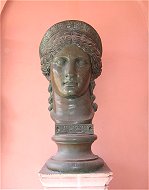Hera LudovisiMuseum Label: Chiurazzi description: |
Subject info:
The goddess Hera was the protectoress of women and childbirth and was therefore very
popular with Roman matrons. In this head sculpture she is portrayed with a typical Roman
hair style.
Not many people today have heard of the Juno Ludovisi, but it was very celebrated once,
particularly among German scholars and intellectuals of the 18th and 19th centuries who
admired its elegantly classicizing style. Goethe owned a cast of it; when he traveled to
Rome, he was particularly eager to see the original, and it did not disappoint him. But
whom or what it represents remains controversial. As with so many antiquities,
unfortunately, its place and date of discovery are unknown, leaving us to infer what we
can only from the object itself.
This head originally belonged to a statue: the rounded plug at the base of the neck would
have fit into a socket in a separately carved torso. The complete work would have been
enormous, looming high above the viewer’s eye level. Such colossal scale suggests a
cult statue of a goddess in a temple, and as the name “Juno Ludovisi” implies,
that is exactly what everyone assumed for years. The serenely beautiful face, with its
idealized, regular features, the straight line from forehead to nose, and the heavy,
rounded line of the jaw and chin, all conformed to Greek and Roman conventions for
deities. But colossal scale was appropriate for other types of images as well. Literary
records, for example, tell us that the emperor Caligula dedicated a statue of his beloved
sister Drusilla, after she died, in the temple of Venus Genetrix, and that the statue was
equal in scale to that of the goddess. Drusilla had been deified, and could appropriately
appear in this manner alongside the divine ancestress of her family. Archaeological
discoveries of sculptures and datable inscriptions indicate that colossal images could
sometimes even honor subjects who were still alive.
Conceivably, then, the “Juno Ludovisi” could represent some real person. And as
Andreas Rumpf noticed in 1941, a few features of this work do not belong on the image of a
major goddess. One of them is the hairdo. From the front, the hair conforms perfectly to
standard images of goddesses: it is parted simply in the middle, and drawn back in soft
waves that partly cover the ears, while long corkscrew curls on each side hang to the
shoulders. But in back, we can see that the lady is not wearing a classical-style bun, but
a loop of tightly bound braids that hang down the nape of her neck. Real women, not
goddesses, wear this hairdo in portraits of the first century A.D. Furthermore, one of her
attributes belongs to a human priestess or deified mortal. Around the base of her high,
crescent-shaped diadem is a thick fabric band strung at regular intervals with little
beads. Two long strips hang down from it on each side of her neck, intertwined with her
loose locks of hair. This ornament is an “infula,” a band worn “in the
manner of a diadem (i.e, encircling the head) from which fillets hang down on each
side.” (Isid. Orig. 1.30.4). The infula can identify the wearer as a priestess or a
suppliant, and can also be draped on altars, or on the horns of sacrificial animals. Its
exact meaning depends on context, but it confers an aura of sanctity on some mortal being
or man-made thing.
https://www.brynmawr.edu/Alumnae/bulletin/juno.htm
